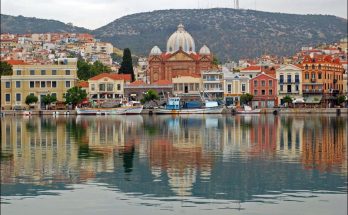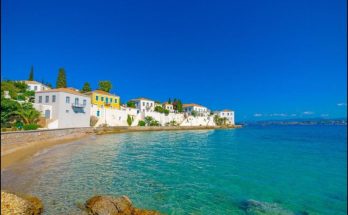While you’re atop the Acropolis, look carefulIy for the delicate, little Ionic TempIe of Athena Nike (to your right as you approach the main entrance to the Acropolis, located almost over the stairs), which still has same of its original friezes depicting battles with the Persians and the Gods of Olympus; the temple is dedicated to the “WingIess Victory”-wingless, else victory can fly away…
Then, walk to the Erechtheum, a temple perched on the originaI site of the even older Temple to Athena, which is supposed to have stood on the pIot of Iand where Athena and Poseidon battled it out for God-supremacy of Athens. Athena brought forth an olive tree (there is still a little tree in front of the temple!) and Poseidon smote the earth and brought forth sea-water. You’ll probably remember the Temple best for its Caryatides (or Maidens), six of them easily and gracefully supporting a heavy porch ceiling on their heads. The Erechtheum records the disasters of Athens. We do not know when it was begun, but it is recorded that in 409 it was unfinished.
The original date of the little temple to Nike Apteros (the Wingless Victory) is not precisely known. It is obvious, however, that it must date from about the same time as the other Propylaea buildings. One might suppose that the architects of the Propylaea, when they found their plans crippled by the neighbourhood of this sacred site, set themselves to make a virtue of necessity; since their entrance buildings were curtailed, they may have consoled themselves by balancing the group with this little gem of Ionic architecture.
To find a temple outside the sanctuary gates is unusual, and the fact that its position never strikes one as strange is just another tribute to the skill with which the proportions of the building are fitted to the site. The spot must have been sacred to Athena from quite early times and was associated with her in her victorious aspect as “Athena Nike.” Then, as the process of differentiation continued, the precinct was said to be sacred to Victory, and Athena’s name was dropped. But the old wooden image kept on the spot was really an image of Athena and not of a Winged Victory. So the pretty tale was invented that the ground and afterwards the temple were dedicated to a Wingless Victory who would never fly away.
Less than three hundred and fifty years ago, the little temple of Athena Nike was still standing, nearly intact, damaged not at all by men and very little by time. Suddenly it disappeared from travellers’ accounts and visitors’ recollection. It had been dismantled to its lowest courses, and the blocks had been employed by the Turks to build retaining walls and a battery at this western outpost of their fortress of the Acropolis. Smooth wallblocks and delicately carved architectural members were with equal unconcern employed for this new enterprise.
After the Greek liberation from the Turks, and under official patronage of the new king of the Hellenes, the architect Ross cleared away these accretions of unpleasant memory, identified the ancient stones, and re¨erected the little temple on its dizzy bastion. At this same time, broken fragments of a relief began to come to light, which after a brief bewilderment were recognised as portions of a parapet once surmounting and surrounding the bastion of the temple. The lovely “Sandalbinder” and the virtually complete slab of the Victories with the sacrificial bull were among the first pieces to be found.
There can be no doubt concerning the original location of the sculpture. The temple bastion was crowned by a projecting moulding, here and there still discernible: and upon this final course of marble, slightly overlapping its outer edge, the parapet slabs were set and dowelled into place. The existence of two right¨angled corner pieces forces us to assume at least four flanks to the Parapet; for the northwest corner of the bastion is built to a peculiar obtuse angle and hence could not carry either of these right¨angled blocks.
We are thus obliged to reckon, not merely with a return of the Parapet along the little flight of steps at the east, but also with a return along the long south flank of the bastion. Here, as Dinsmoor argues, it is difficult to see how the Parapet could end except against the very steps of the Propylaea. Yet the present study will bring practically conclusive evidence to show that Heberdey’s suppo¨ sition was the correct one, and that the reliefs actually ended in line with the east face of the Nike Temple. The carved expanse thus totalled almost exactly a hundred ancient feet and was practically the same in length as the contemporary frieze within the Apollo Temple at Bassae (the famous “Phigaleia Frieze” of the British Museum).
The carving on the Parapet was confined to its outer face, the inner side toward the temple being smooth and in a single surface except for the minute and almost invisible projection of a headband four inches broad. The slab showing two Victories with a sacrificial bull will give the best notion of the original appearance: a low ledge, sloping gently outward, served as groundline for the reliefs, while a rather ponderous headband, projecting equally far, topped them with an emphatic horizontal which continued from slab to slab through the Parapet’s entire length.
By mounting a chair or stepladder, the curious may see on top of this par¨ ticular slab a series of small bored holes running parallel to the face of the stone, halfway between front and rear, and spaced very evenly at an interval of some six inches. These holes must have served to hold a metal grille of upright rods. The parapet of stone being little more than waist¨-high, some further restraint for the incautious was apparently deemed advisable. This precaution was particularly necessary on the west flank; for there the temple comes so close to the edge of the bastion that the Parapet was forced to straddle the lowest step. A visitor to the temple’s western colonnade would have stood almost as high as the top of the marble parapet, a foot and a half away.
That there was public access to the area around the temple seems to follow from the observation that at the top of the little northeast stairway, where the Parapet began, a two¨foot passage was left open between parapet and temple. Such, at least, must be the inference from the observation that the end face of the Parapet shows no trace of any barrier. We conclude that this short east flank was merely intended to guard the stair¨well, not to hem the temple in. In consequence, we cannot assume (as some commentators have done) that at its other end the Parapet similarly turned inward from its southern face to make a spur against the temple’s southeast corner.
The material of the Parapet is Pentelic marble of finest quality. Perhaps a difference in the quarry veins, perhaps a difference in exposure to weather or soil, is accountable for the present range in tint and surface texture of the frag¨ ments. There are no longer any traces of the brilliant colors which once were applied to the background and to the wings, garments, hair, features, and per¨ haps even the nude flesh of the figures. It is possible that with the loss of these colors some of the intended sculptural effect has become weakened or obscured.
Visits: 338





